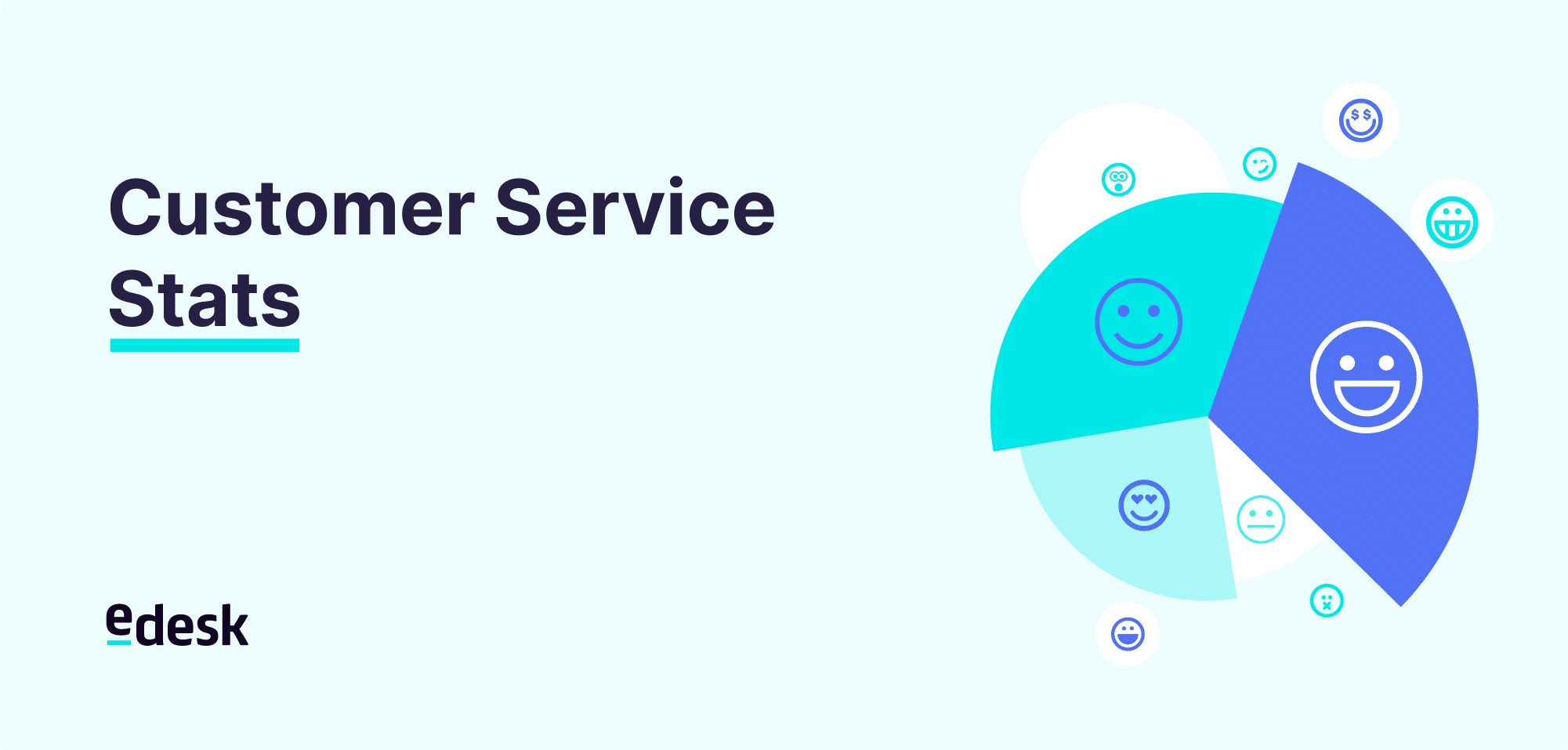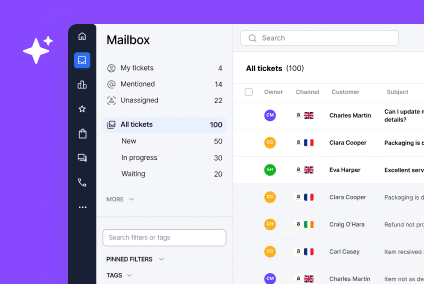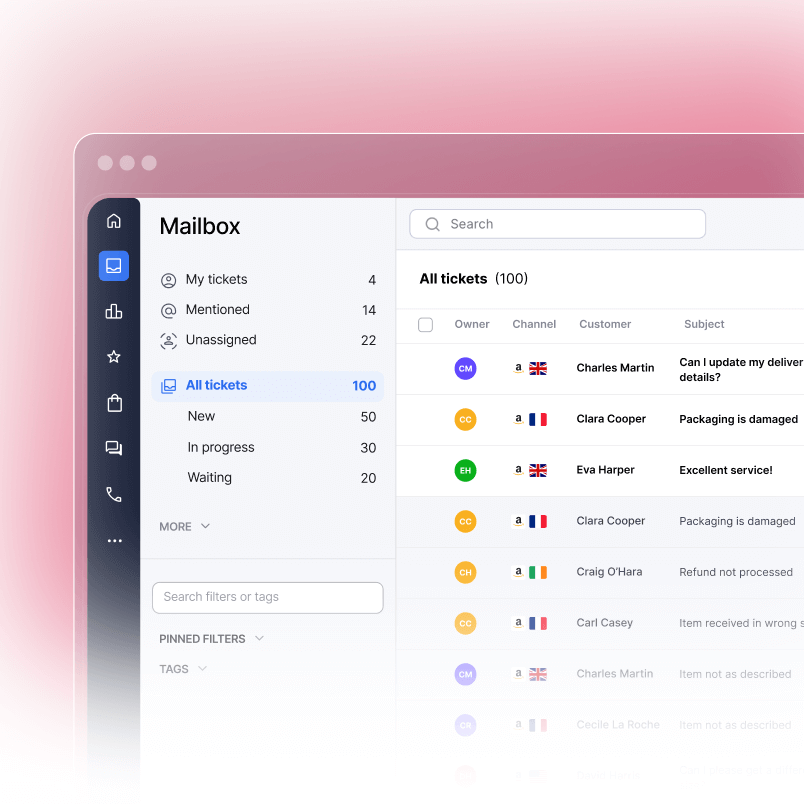Customer service is one of the most important elements of your business. It can be the difference between making and losing a sale, the difference between having repeat customers or not, and the difference between whether your brand is perceived favourably or not.
With more people shopping online than ever before in 2025, customer service continues to be an important factor at every touchpoint and a key part of every brand’s strategic proposition.
Need proof?
Research backing up the importance of customer service is readily available for those curious about the impact that customer service can have on your business and why investing in it is one of the smartest decisions you’ll ever make.
Here are some of the latest customer service statistics and trends that can help guide your company’s customer service strategy in 2021.
Customer Service and Brand Loyalty
- 67% of customers worldwide say that customer engagement levels have improved in the last two years. (Ameyo)
- 96% of consumers globally say customer service is an important factor in their choice of loyalty to a brand. (Microsoft)
- 89% of consumers reported having switched to doing business with a competitor following a poor customer experience. (Harris Interactive)
- Loyal customers are seven times as likely to test an offering, five times as likely to buy again and four times as likely to refer. (Temkin Group)
- 75% of brands report that they are measuring customer engagement but cannot define what it is. (Kolsky)
- 86% of buyers are willing to pay more for a great customer experience. (PWC)
- Increasing customer retention rates by 5% increases profits anywhere from 25% to 95%. (Bain & Company)
- 68% of consumers say they are willing to fork out more for products and services from a brand that’s known to offer good customer service experiences (HubSpot)
- Other customers can sometimes be the best ambassadors for your company: 67% of customer service interactions can be handled by a dedicated community of core customers. (Kolsky)
- Your business has a 60-70% chance of selling to an existing customer, while it only has a 5-20% chance of selling to a new prospect. (Glance)
In a nutshell: Good customer service is super important within your business. It goes a long way towards retaining customers and securing loyalty and repeat business.
The Business Benefits of Providing Good Customer Service
- Investing in new customers is between 5 and 25 times more expensive than retaining existing ones. (Invesp)
- 93% of customers are likely to make repeat purchases with companies who offer excellent customer service. (HubSpot Research)
- 73% of companies with “above average” customer experiences perform better financially than their competitors. (Temkin Group)
- Your online conversion rate can improve by roughly 8% when you include personalised consumer experiences. (Trust Pilot)
- When it comes to making a purchase, 64% of people find customer experience more important than price. (Gartner)
- On average, companies that invest in their customer experience also observe an improvement in employee engagement by roughly 20%. (Mckinsey)
- Over a 12 month period, proactive customer service can lead to a 20-30% reduction in call centre calls — lowering call centre operating costs by as much as 25% (MyCustomer)
- 90% of CEOs believe the customer has the greatest impact on their business. (PWC)
- Businesses can grow their revenue by as much as 8% above their competition when they improve the customer service experience. (Bain and Company)
In a nutshell: Good customer service is super important within your business. It goes a long way towards retaining customers and securing loyalty and repeat business.
Takeaway: Investing in good customer service can increase conversions and revenue and lower call centre operating costs.
The Perils of Poor Customer Service
- Attracting a new customer is 6-7 times more expensive than retaining a current one. (Salesforce)
- One-third of consumers say they would consider switching companies after just one instance of bad customer service. (American Express)
- Women tell an average of ten people when they have had a poor customer service experience. (American Express)
- Men tell twice as many people as women both about their poor experiences (21 compared to 10) and good ones (15 compared to 7). (American Express)
- 91% of customers who are unhappy with a brand say they will leave without ever complaining. (Kolsky)
- Although fewer customers may be experiencing problems, more customers are inclined to complain about customer service than ever before. (Deloitte)
- Just one negative experience will cause 51% of customers to never do business with that company again. (NewVoiceMedia)
- It takes 12 positive customer experiences to make up for one negative experience. (Glance)
- Feeling unappreciated is the #1 reason customers switch away from products and services. (NewVoiceMedia)
- A customer is four times more likely to switch a competitor if the problem they’re having is service-based. (Bain and Company)
- 33% of customers who abandoned a business relationship last year did so because personalisation was lacking. (Accenture)
- Within the last year alone, reported merchandise returns went up from $351 billion to $369 billion, and an estimated $24 billion was lost to return fraud and abuse. (Appriss)
In a nutshell: Customers will abandon a brand quickly following even just one poor customer service experience. It’s in the interest of your business to ensure any issues are dealt with positively.
Consumer Attitudes Towards Customer Service
- 68% of consumers say that a brand’s perception becomes positive when companies send proactive customer service notifications to them. (Microsoft)
- 33% of customers are most frustrated by having to wait on hold. The same percentage of customers are most frustrated by having to repeat themselves to multiple support reps. (HubSpot Research)
- 40% of customers want customer service reps to take care of their needs faster. (American Express)
- 48% of consumers expect special treatment for being a good customer. (Accenture)
- Two-thirds of customers are willing to share personal information with companies but only in exchange for some perceived value. (Accenture)
- 72% of consumers say that when contacting customer service they expect the agent to “know who they are, what they have purchased and have insights into their previous engagements.” (Microsoft)
- 64% of consumers want brands to connect with them. (Sprout Social)
- 90% of Americans use customer service as a deciding factor when choosing to do business with a company. (American Express)
- One-third of all consumers consider the most important aspect of good customer service experiences to be being able to get their problem solved in one single sitting regardless of the amount of time spent. (Statista)
- 86% of customers have to contact customer service multiple times for the same reason. (InfoLink)
- 73% of customers say that the reason they fall in love with a brand is because of friendly customer service representatives. (RightNow)
- 73% of consumers say that valuing their time is the most important thing a company can do when providing customer service. (Forrester)
- 70% of the customer’s journey is based on how the customer feels they are being treated. (McKinsey)
- 90% of customers rate immediate responses as important or higher when they have a question. (Hubspot)
- Only 1% of customers feel that their expectations of customer service are always met. (Source: Slideshare)
- 68% say a pleasant representative is a key to their recent positive service experiences. (American Express)
- 84% of customers report that their expectations had not been exceeded in their last interaction with customer service. (Harvard Business Review)
In a nutshell: Not only is unparalleled customer service required when it comes to dealing with an issue, but being friendly and treating your customer as if they are incredibly important must be factored in too. Be knowledgeable and exceed your customer’s expectations.
Customer Service and Millennials
- 63% of millennials begin their customer journey online. (Microsoft)
- 74% of millennials say their perception of a brand improves if the company responds to their social media enquiries promptly. (Microsoft)
- 66% of 18-34-year-olds say their customer service expectations have risen in the last year. (Microsoft)
- 71% of consumers under the age of 25 believe quickness in responses from customer service representatives improves their experience. (Comm100)
- Millennials choose live chat as their preferred support channel, with 52% saying they would rather converse over text. (Comm100)
- One in two millennials has complained about a brand on social media. Microsoft
- Millennials are the only demographic who tell more people when they have a good customer service experience rather than a bad one. (American Express)
In a nutshell: Millennials want more from their customer service experience – but if you do good, they will sing your praises! Millennials do not have such brand loyalty as other demographics, and they are impatient, so the quickness and outcome of their customer service experience is key.
Social Media and Customer Service
- 31% of customers say they have reached out to a company via Twitter. (Forrester)
- 79% of customers who share their complaints online see their complaints ignored. (Slideshare)
- 57% of customers would rather contact companies via digital media such as email or social media rather than use voice-based customer support. (Ameyo)
- 65% of people aged 18-34 believe social media is an effective channel for customer service, while 75% of people aged 55 and over do not. (Microsoft)
- 33% of customers have contacted a company through Facebook or similar social channels. (Forrester)
- 48% of consumers expect a response to social media questions and complaints within 24 hours. (Statista)
- 80% of consumers use social media to engage with brands. (Forrester)
- 55% of people aged 18-34 have praised a brand or its customer service over social media. (Microsoft)
- The average wait time for a response on social media is within an hour. (Playvox)
In a nutshell: Social media is a popular platform for engagement – and complaints – to be made but is largely ignored by companies. Social media is accessible and offers you the opportunity to respond promptly to issues – so should be part of your overall customer service strategy. You will be in a better position to offer customer satisfaction if you are on the ball with your social media offerings.
Customer Experience (CX)
- More than 89% of companies see customer experience as a key factor in driving customer loyalty and retention. (invesp)
- 81% of companies view customer experience as a competitive differentiator. (Dimension Data)
- A moderate improvement in customer experience (CX) would impact the revenue of a typical $1 billion company an average of $775 million over three years. (Temkin Group)
- 99% of customer experience and success leaders believe customer experience management has a positive impact on their business. (Lumoa)
- 8% of CX professionals said that although their companies embrace digital, they don’t think they’ll keep pace with the speed of technology change. (Oracle)
- The customer experience management market is estimated to be worth $14.9 billion by 2025. (Markets and Markets)
- 46% of businesses say their number one priority in the next five years is their customer experience. (SuperOffice)
- 34% of companies are implementing “customer journey mapping” into their customer service. (Kolsky)
- 46% of decision-makers in global contact centres expect their business to grow 5-10% in the next year, while 14% project a massive growth of more than 10%. (Forrester)
- With 89% of businesses soon to be expected to compete mainly on customer experience, organisations that take customer experience seriously will stand out from the noise and win loyal customers. (Gartner)
- Customer experience management market worldwide is worth as much as $7.6 billion in 2020 (Grand View Research)
In a nutshell: Large and small companies are starting to understand the importance of customer service and the role it plays. Customer service is an area that you can improve upon to effectively compete against your competitors and should not be over-looked.
Omnichannel Customer Service
- Globally, companies respond to 85% of all customer service questions across platforms. (Microsoft)
- For more complicated interactions, such as payment disputes, 40% of customers prefer talking to a real person over the phone. (American Express)
- 69% of American adults online say that they shop more with businesses whose online and offline customer service is consistent. (Forrester)
- More than three-quarters (76%) of all consumers prefer the traditional medium of phone calls to reach customer support representatives (CFI Group)
- Nearly one-third of customers report sending a mobile/SMS message to the company requesting assistance. (Forrester)
- 29% of global companies prefer smartphones and mobile devices to traditional computers due to mobility. (Kolsky)
- The most commonly used digital customer service channel is still email, with 54% of consumers using email for customer service issues in the last year. (Forrester)
- Globally, only 5% of customer service interactions begin with a face-to-face meeting. (Microsoft)
- One-third of all customers use their mobile device to initiate contact with customer service. (Microsoft)
- 66% of consumers have used at least 3 different communication channels to contact customer service. (Microsoft)
- 9 in 10 customers say they want absolute omnichannel service and expect a seamless experience when moving from one communication method to another, such as phone to text or chat to phone. (NICE inContact)
In a nutshell: Face-to-face customer service is all but dead, however, a variety of customer service contact options must be implemented in your business to suit the many different demographics and types of queries you may receive. What’s more, all of these methods of communication must seamlessly connect so that threads can be picked up through different channels.
Customer Self-Service
- 90% of consumers expect an online portal for customer service. (Microsoft)
- 70% of customers expect a company’s website to include a self-service application. (Steven Van Belleghem)
- 77% of consumers report having used a self-service support portal. (Microsoft)
- Over half of consumers say that the main reason they cannot resolve an issue on their own is because there is too little information online. (Microsoft)
In a nutshell: If you don’t have a knowledge base facility, FAQs or a way for customers to find answers and information regarding their common issues, set one up!
Learn more about eDesk’s knowledge base add-on.
The Role of Artificial Intelligence (AI) in Customer Service
- 31% of organisations have already invested in technology like AI to outpace the competition. (Accenture)
- 76% of collaboration leaders are investing or expanding their emerging technology investment. (Accenture)
- AI augmentation will create $2.29 trillion of business value by 2021. This value is equal to 6.2 billion hours of worker productivity globally. (Gartner)
- AI will power 95% of all customer interactions by 2025, including live telephone and online conversations. (Servion Global Solutions)
- 75% of consumers will still choose to interact with a real person even as the technology for automated solutions improves. (PwC)
- 67% of customers expect to use messaging apps to speak to businesses. (Chatbots Magazine)
- 34% of sales and marketing leaders believe that artificial intelligence will cause the biggest improvement in customer experience. (Oracle)
- 47% of organisations are expected to implement chatbots for customer support services in 2021. (Linchpin)
- By 2030, 70% of companies will have adopted some form of AI and the majority of enterprises will be using a full range of AI technology. (McKinsey)
In a nutshell: AI is big and can help you streamline your business and take your customer service to the next level, but allowing you to retain more traditional methods of customer service too.
Final Thoughts
So, there you have it, 99 incredible statistics that paint a picture of the customer service industry, highlighting the importance of investing in your customer experience offering.
Looking at consumer attitudes towards customer service and the data points that underpin them, business owners can get a sense of where improvements can be made to close gaps and minimise lost revenue.
From there, reviewing customer service industry statistics gives you a good overview of the market, its potential and what’s to come next. Taken as a whole, all of this data can be hugely useful in important business decisions you make and that may just make 2025 your best year yet.




